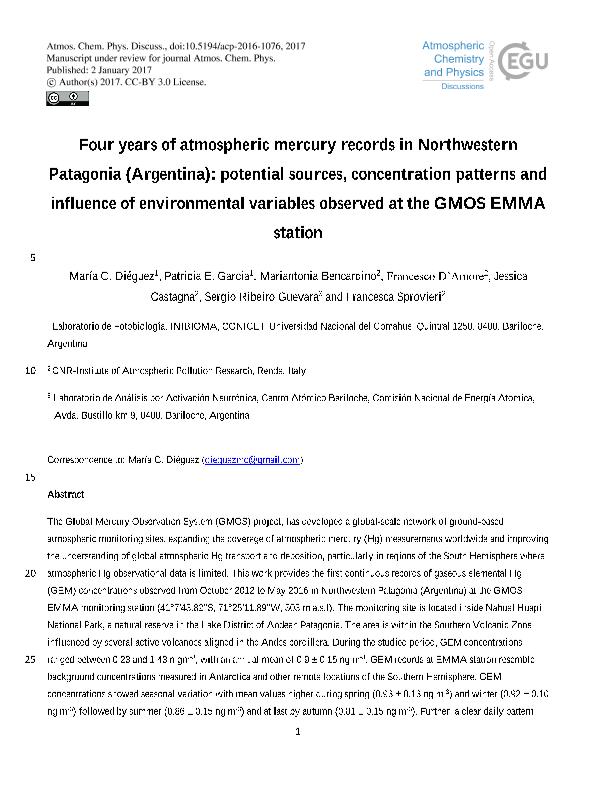Artículo
Four years of atmospheric mercury records in Northwestern Patagonia (Argentina): potential sources, concentration patterns and influence of environmental variables observed at the GMOS EMMA station
Dieguez, Maria del Carmen ; Garcia, Patricia Elizabeth
; Garcia, Patricia Elizabeth ; Bencardino, Mariantonia; D’Amore, Francesco; Castagna, Jessica; Ribeiro Guevara, Sergio; Sprovieri, Francesca
; Bencardino, Mariantonia; D’Amore, Francesco; Castagna, Jessica; Ribeiro Guevara, Sergio; Sprovieri, Francesca
 ; Garcia, Patricia Elizabeth
; Garcia, Patricia Elizabeth ; Bencardino, Mariantonia; D’Amore, Francesco; Castagna, Jessica; Ribeiro Guevara, Sergio; Sprovieri, Francesca
; Bencardino, Mariantonia; D’Amore, Francesco; Castagna, Jessica; Ribeiro Guevara, Sergio; Sprovieri, Francesca
Fecha de publicación:
01/2017
Editorial:
Copernicus Publications
Revista:
Atmospheric Chemistry and Physics Discussions
ISSN:
1680-7375
Idioma:
Inglés
Tipo de recurso:
Artículo publicado
Clasificación temática:
Resumen
The Global Mercury Observation System (GMOS) project, has developed a global-scale network of ground-based atmospheric monitoring sites, expanding the coverage of atmospheric mercury (Hg) measurements worldwide and improving the understanding of global atmospheric Hg transport and deposition, particularly in regions of the South Hemisphere where atmospheric Hg observational data is limited. This work provides the first continuous records of gaseous elemental Hg (GEM) concentrations observed from October 2012 to May 2016 in Northwestern Patagonia (Argentina) at the GMOS EMMA monitoring station (41°7´43.82" S, 71°25´11.89" W, 803 m a.s.l). The monitoring site is located inside Nahuel Huapi National Park, a natural reserve in the Lake District of Andean Patagonia. The area is within the Southern Volcanic Zone, influenced by several active volcanoes aligned in the Andes cordillera. During the studied period, GEM concentrations ranged between 0.23 and 1.43 ng m−3, with an annual mean of 0.9 ± 0.15 ng m−3. GEM records at EMMA station resemble background concentrations measured in Antarctica and other remote locations of the Southern Hemisphere. GEM concentrations showed seasonal variation with mean values higher during spring (0.93 ± 0.13 ng m−3) and winter (0.92 ± 0.10 ng m−3) followed by summer (0.86 ± 0.15 ng m−3) and at last by autumn (0.81 ± 0.15 ng m−3). Further, a clear daily pattern was observed, with higher GEM levels during day-time than at night-time across all seasons. Multivariate analyses showed that GEM levels are chiefly determined by meteorological parameters, and, in particular by the westerly winds which represented the most influential variable on GEM records. In order to investigate the potential impact of natural and/or anthropogenic emission sources as well as the role played by the long-range transport on GEM levels, analyses of HYSPLIT backward trajectories (BWT) were carried out for different periods characterized by low and high GEM concentrations. The BWT analysis highlighted the influence of clean oceanic air masses and also of the local and regional active volcanoes in the Andes cordillera.
Palabras clave:
Mercurio
,
Atmósfera
,
Especiacion
,
Patagonia
Archivos asociados
Licencia
Identificadores
Colecciones
Articulos(INIBIOMA)
Articulos de INST. DE INVEST.EN BIODIVERSIDAD Y MEDIOAMBIENTE
Articulos de INST. DE INVEST.EN BIODIVERSIDAD Y MEDIOAMBIENTE
Citación
Dieguez, Maria del Carmen; Garcia, Patricia Elizabeth; Bencardino, Mariantonia; D’Amore, Francesco; Castagna, Jessica; et al.; Four years of atmospheric mercury records in Northwestern Patagonia (Argentina): potential sources, concentration patterns and influence of environmental variables observed at the GMOS EMMA station; Copernicus Publications; Atmospheric Chemistry and Physics Discussions; 1-2017; 1-18
Compartir
Altmétricas



